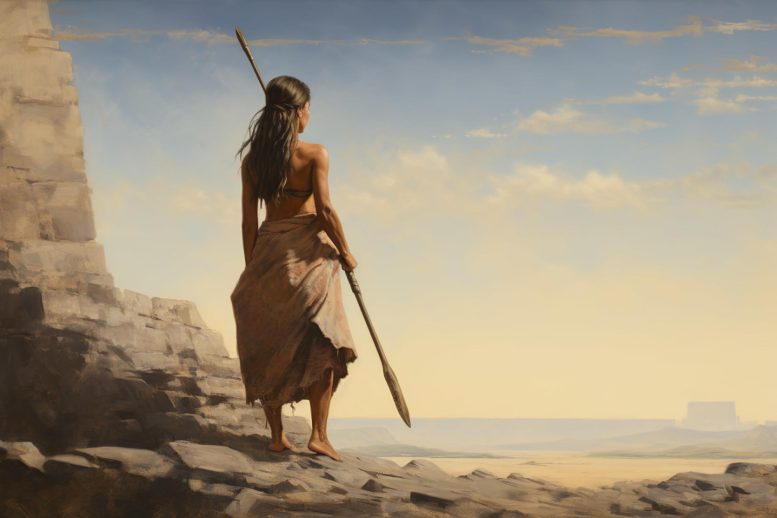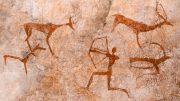
New research reveals that prehistoric women were not only involved in hunting but may have been physiologically better suited for it. This research, based on physiological studies and archaeological evidence, underscores the endurance capabilities of women and the lack of a strict division of labor in early societies. The study emphasizes the need to reevaluate long-standing biases about female capabilities.
When Cara Ocobock was a young child, she often wondered at the images in movies, books, comics, and cartoons portraying prehistoric men and women as such: “man the hunter” with spear in hand, accompanied by “woman the gatherer” with a baby strapped to her back and a basket of crop seeds in hand.
“This was what everyone was used to seeing,” Ocobock said. “This was the assumption that we’ve all just had in our minds and that was carried through in our museums of natural history.”
Many years later, Ocobock, an assistant professor in the Department of Anthropology and director of the Human Energetics Laboratory at the University of Notre Dame, found herself as a human biologist studying physiology and prehistoric evidence and discovering that many of these conceptions about early women and men weren’t quite accurate. The accepted reconstruction of human evolution assumed males were biologically superior, but that interpretation wasn’t telling the whole story.
Relying on both physiological and archaeological evidence, Ocobock and her research partner, Sarah Lacy, an anthropologist with expertise in biological archaeology at the University of Delaware, recently published two studies simultaneously in the journal American Anthropologist. Their joint research, coming from these two angles, found that not only did prehistoric women engage in the practice of hunting, but their female anatomy and biology would have made them intrinsically better suited for it.
Of her and her co-author’s dual-pronged research, which was the cover story for the November issue of Scientific American, Ocobock said, “Rather than viewing it as a way of erasing or rewriting history, our studies are trying to correct the history that erased women from it.”
Female physiology and estrogen, the ‘unsung hero of life’
In their physiological study, the two researchers explained that prehistoric females were quite capable of performing the arduous physical task of hunting prey and were likely able to hunt successfully over prolonged periods of time. From a metabolic standpoint, Ocobock explained, the female body is better suited for endurance activity, “which would have been critical in early hunting because they would have had to run the animals down into exhaustion before actually going in for the kill.”
Two huge contributors to that enhanced metabolism are hormones — in this case, estrogen and adiponectin, which are typically present in higher quantities in female bodies than in males. These two hormones play a critical role in enabling the female body to modulate glucose and fat, a function that is key in athletic performance.
Estrogen, in particular, helps regulate fat metabolism by encouraging the body to use its stored fat for energy before using up its carbohydrate stores. “Since fat contains more calories than carbs do, it’s a longer, slower burn,” Ocobock explained, “which means that the same sustained energy can keep you going longer and can delay fatigue.”
Estrogen also protects the body’s cells from damage during heat exposure due to extreme physical activity. “Estrogen is really the unsung hero of life, in my mind,” Ocobock said. “It is so important for cardiovascular and metabolic health, brain development, and injury recovery.”
Adiponectin also amplifies fat metabolism while sparing carbohydrate and/or protein metabolism, allowing the body to stay the course during extended periods, especially over great distances. In this way, adiponectin is able to protect the muscles from breaking down and keeps them in better condition for sustained exercise, Ocobock explained.
The female body structure itself is another element Ocobock and Lacy found to be of advantage in terms of endurance and effectiveness for prehistoric hunters. “With the typically wider hip structure of the female, they are able to rotate their hips, lengthening their steps,” Ocobock detailed. “The longer steps you can take, the ‘cheaper’ they are metabolically, and the farther you can get, faster.
“When you look at human physiology this way, you can think of women as the marathon runners versus men as the powerlifters.”
Archaeology tells more of the story of ‘woman the hunter’
Several archaeological findings indicate prehistoric women not only shared in the resulting injuries of the dangerous business of close-contact hunting but that it was an activity held in high esteem and valued by them. “We have constructed Neandertal hunting as an up-close-and-personal style of hunting,” Ocobock said, “meaning that hunters would often have to get up underneath their prey in order to kill them. As such, we find that both males and females have the same resulting injuries when we look at their fossil records.”
Ocobock described those traumatic injuries as being similar to those received by modern-day rodeo clowns — injuries to the head and chest where they were kicked by the animal, or to the limbs where they were bitten or received a fracture. “We find these patterns and rates of wear and tear equally in both women and men,” she said. “So they were both participating in ambush-style hunting of large game animals.”
Second, Ocobock said, there is evidence of early female hunters in the Holocene period in Peru where females were buried with hunting weapons. “You don’t often get buried with something unless it was important to you or was something that you used frequently in your life.
“Furthermore, we have no reason to believe that prehistoric women abandoned their hunting while pregnant, breastfeeding, or carrying children,” Ocobock added, “nor do we see in the deep past any indication that a strict sexual division of labor existed.”
The bottom line, Ocobock noted, was that “hunting belonged to everyone, not just to males,” especially in prehistoric societies where survival was an all-hands-on-deck activity. “There weren’t enough people living in groups to be specialized in different tasks. Everyone had to be a generalist to survive.”
Fighting bias
“This revelation is especially important in the current political moment of our society where sex and gender are in a spotlight,” Ocobock said. “And I want people to be able to change these ideas of female physical inferiority that have been around for so long.”
When talking about reconstructing the past in order to better understand it — and to conduct “good science” — Ocobock said scientists have to be extremely careful about how modern-day bias can seep into one’s interpretations of the past. She cautioned that researchers have to be aware of their own biases and make sure they are asking the proper questions so the questions don’t lead them down the road of looking for what it is they want to see.
“We have to change the biases we bring to the table, or at least to give pause before we assign those biases. And in a broader sense, you cannot outrightly assume somebody’s abilities based on whatever sex or gender you have assigned by looking at them,” Ocobock concluded.
Reference: “Woman the hunter: The physiological evidence” by Cara Ocobock and Sarah Lacy, 4 September 2023, American Anthropologist.
DOI: 10.1111/aman.13915









“… not only did prehistoric women engage in the practice of hunting, but their female anatomy and biology would have made them intrinsically better suited for it.”
Then why were males consistently larger than females? Why do anthropologists not find the speculated behavior among historical, but primitive societies? Pursuing wounded or poisoned animals can take as much as two or three days in societies that still practice that style of hunting in Africa. If a female hunter has a child that requires nursing, which will last 4 or 5 years, they will have to find a surrogate to feed their child while hunting. Meanwhile, she will have discomfort if she is lactating and not being nursed. (Routinely being gone for up to a week and not being nursed may prematurely terminate milk production.) It is important that the kill be returned to the tribe, to share. A man who is bigger and stronger can carry more meat, thus making the hunt more efficient if all the meat can be returned. Anything not returned immediately will almost certainly be found and consumed by scavengers
“With the typically wider hip structure of the female, they are able to rotate their hips, lengthening their steps,” Ocobock detailed. “The longer steps you can take, the ‘cheaper’ they are metabolically, and the farther you can get, faster.”
Yet, despite this hypothetical, it has been my experience that the only women who don’t complain and ask me to slow down on a hike are those who are close to my height. Olympic athletic event records are typically, if not exclusively, held by men for activities such as javelin throwing, hammer toss, or sprinting.
“When you look at human physiology this way, you can think of women as the marathon runners versus men as the powerlifters.”
Why would evolution have provided greater strength to men if it wasn’t an advantage for survival of the tribe? What role would men serve if women made better hunters?
“… meaning that hunters would often have to get up underneath their prey in order to kill them.”
The pygmies in Africa practice this style of hunting for forest elephants. Being smaller might be an advantage for this hunting practice.
A woman who is having her period, in societies without absorbent, woven fabric, would be safer among other members of the tribe because leaving a blood trail while hunting would lead apex predators right to her, from behind, while her focus would be forward on the prey she was hunting. That would be a good way to lose her toddler. The plains Indians in North America would banish women during their periods to an area outside the immediate encampment.
“Furthermore, we have no reason to believe that prehistoric women abandoned their hunting while pregnant, breastfeeding, or carrying children,”
So says the academics who have probably never hunted big game. The extra weight of a child would slow a female hunter down. Small children have unpredictable episodes of crying that startles prey and attracts predators. When any female predator goes hunting, it leaves the cubs either hidden or in the care of other adults. Surely humans would be as wise.
“And I want people to be able to change these ideas of female physical inferiority that have been around for so long.”
And it appears that the desire is so strong that it has blinded her/them to counter arguments that they apparently didn’t consider. And they complain about bias!
It’s great criticism, and I’m glad someone is doing it. It’s hard to dignify these political studies. The sciences seem to need a woke agenda for funding now. Funny how the humanities seem to have taken over the universities, when the sciences were their bread and butter. All my old arguments about the humanities being an ultimate goal of the sciences are haunting me. At least this is anthropology, not archaeology.
Their goal is to reverse gender roles and prove female superiority. That’s pretty much stated when the intention is to “correct history” which they assume “assumed males were biologically superior”, begging the question. Their idea of gathering being a non-endurance activity needing the “powerlifters” versus hunting is ludicrous. They have very obviously never been hunting, when they state “they would have had to run the animals down into exhaustion before actually going in for the kill”. As much as their idea of bands of running paleolithic pregnant women hunters chasing after goats and deer entertains me, it’s insulting to people equally as intelligent as modern humans, only capable of surviving and multiplying in a reality when life was nasty brutish and short. I mean, try it. Let’s see that study.
Obviously women hunted. For a balanced diet with minimal society, everyone had to be capable. As you’ve pointed out, there were times in their lives when prehistoric women ancestors simply could not hunt effectively, so it cannot be their natural role in a society or family.
The study is paywalled. The abstract just talks about running as the main determinant in hunting, as if hominids are built for that. I assume the full study explains how the women ran on all fours and the men were pregnant.
“Obviously women hunted. For a balanced diet with minimal society, everyone had to be capable.”
Among indigenous North American tribes, there is evidence that both women and children would hunt small animals like rabbits, using throwing sticks or rocks. I have found very small obsidian ‘bird points’ in Northern Arizona that would have required their use with small arrows and correspondingly smaller bows. I can imagine that hunting birds with these smaller tools would be a natural fit for children of either sex. So, yes, women hunted. But, the larger and more dangerous animals were probably hunted primarily by men. It would probably require a ‘berzerker’ suffering from ‘testosterone poisoning’ to take on a Cave Bear or Imperial Mammoth.
Also, see the numerous comments at https://scitechdaily.com/debunking-myths-women-were-prehistoric-hunters-not-just-gatherers/
There’s no reason why women couldn’t hunt, the question is whether or not they did. Humans are effective hunters in part because we possess the endurance to run down wounded prey over long distances. The fact that humans can shed excess heat via sweating is unique and unmatched by any other species.
To suppose that women were better hunters in place of men is simply specious. Every athletic record available shows men are faster, stronger. Women needed good endurance to keep up, with a baby on their hip.
Confirmation bias.
Honestly no one knows squat about actual real life back then, everything is just assumptions.
Humans tend to draw conclusions that support their own beliefs.